Social Security Programme Business Case
View on the whole life costs and benefits of the programme, over a 30 year timeframe to 2050.
Social Security Programme Business Case: Executive Summary
Introduction
The Social Security Programme Business Case (PBC) provides a view on the whole life costs and benefits of the Scottish Government's Social Security Programme, over a 30 year timeframe to 2050. The PBC uses the good practice set out in HM Treasury's Green Book. The five case model clearly explains the strategic context, rationale for change, socio-economic considerations, commercial considerations, financial information and management structures necessary to deliver social security benefits for the people of Scotland. It covers short-term implementation and transition work as well as longer-term activity and measurable improvements resulting from the Programme. The PBC ensures decision making is robust and value for money assured.
This revision of the PBC is in accordance with Audit Scotland's most recent report recommendation. Business cases are not routinely published across the UK public sector; the Scottish Government is acting on its commitment to transparency. The PBC builds on a number of previous documents, notably the outline business case for the Social Security Agency in Scotland[1] which provided the decision-making rationale for setting up Social Security Scotland as an Executive Agency of the Scottish Government, and the Financial Memorandum which underpinned the Social Security (Scotland) Act 2018. These documents were based on the level of understanding available at the time about the scope and nature of the Social Security Programme – the Financial Memorandum makes clear that these were 'initial estimate[s] which could change materially'.
This document is a summary of the Programme Business Case.
Strategic case
The Scottish Government Social Security Programme is delivering the infrastructure necessary for a brand new public service for Scotland, co-designed with our clients, ensuring the service meets the needs of the people of Scotland now and in future. It is the largest and most complex exercise in devolution undertaken since the Scottish Parliament was reconvened twenty years ago. It will impact on the lives of around 1.8 million people[2] in Scotland and pay out an estimated £4 billion[3] by 2024-25, when the Programme concludes and Social Security Scotland is running in steady state. We have ensured the system is future proof, designed with the aim of making future decisions or changes of circumstance straightforward to accommodate.
We have met and surpassed our commitments to date, having established the agency to deliver benefits – Social Security Scotland – and successfully introduced seven benefits, three of which are brand new[4]. We take over full responsibility for the complex disability assistance benefits from April 2020, and work is well advanced on considering design and implementation decisions which will mean real change for how people experience these benefits in a distinctly Scottish system.
We've started work on the new Scottish Child Payment, which will be introduced to all eligible families with a child under 16 by 2022. Ministers have gone further with the early introduction of the benefit, so eligible families with a child under 6 will receive first payments by Christmas. This flagship benefit is being introduced at unprecedented pace as it has the potential to lift 30,000 children out of poverty, reduce the relative child poverty rate by an estimated three percentage points and is a direct contribution to creating a fairer Scotland.
We are committed to delivering a new service which capitalises on the insights of those who are experts by experience. People on our 2,400 strong Experience Panels told us that flexibility in how to communicate with Social Security Scotland is a crucial element of accessibility and of treating people with dignity, fairness and respect, for example, "I think every way of communication should be available to meet the demands of the client base."[5] As well as providing a brand new digital service, we have therefore ensured our clients can pick up the phone and speak to a client advisor who will listen to their concerns and help, and we are building a local delivery service across the country where clients can speak directly to Social Security Scotland staff.
Unlike DWP, who benefit from system assets built up over decades, we are constructing a brand new public service from the ground up. This includes building systems for financial payments, fraud, error and debt, document storage and delivery, case management, cyber security, telephony, redeterminations and appeals, and many others. These create future proof, flexible, adaptable social security infrastructure. The diagram on the next page shows the scale of the Programme structure which has been developed to deliver this new public service. It is followed by a timeline illustrating delivery to date and into the future.
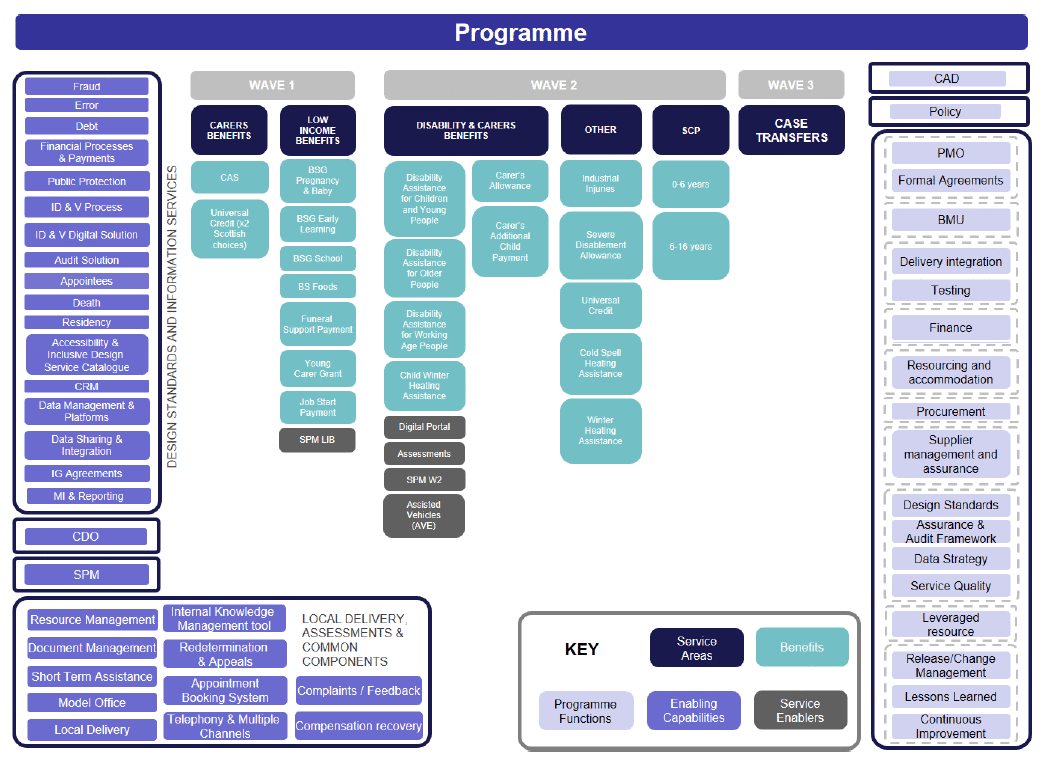
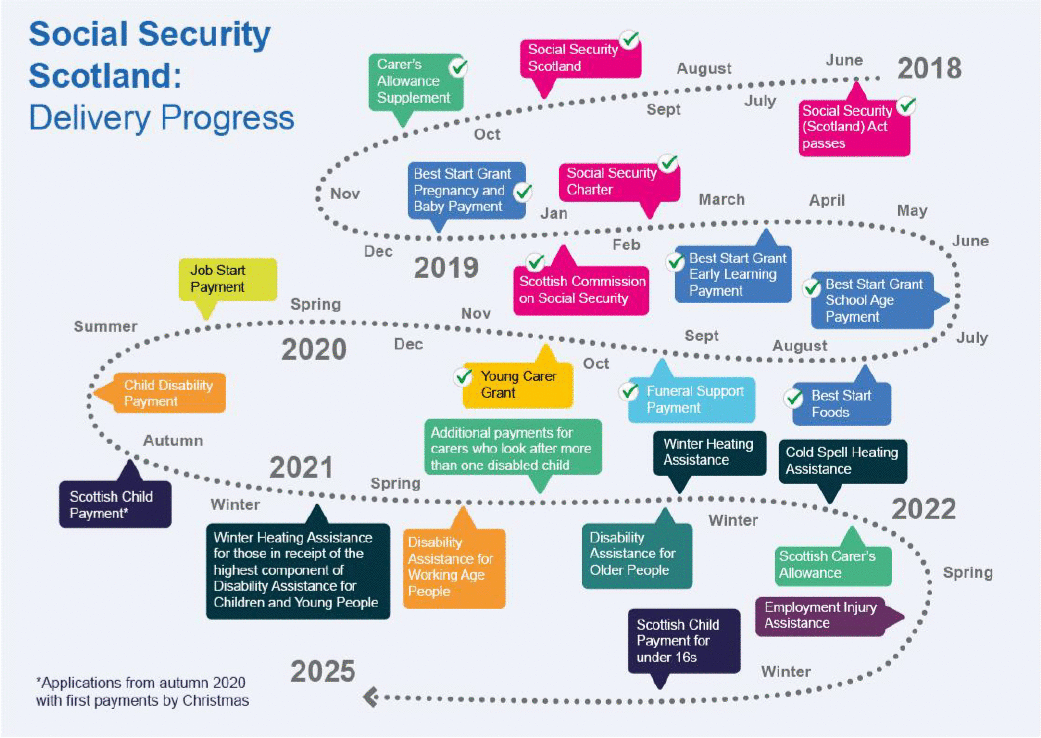
Socio-economic case
The socio-economic case sets out the critical success factors for the Programme at table 3.4 of the PBC. These underpin decision making, ensuring Programme activities align to the overarching vision, principles and objectives for the Scottish social security system, and that the key dimensions of strategic alignment, deliverability, cost and risk are taken into account. These build on the public engagement carried out, in particular, in the run up to the Social Security (Scotland) Act 2018 and in the development of Social Security Scotland's 'Charter', ensuring the needs and views of Scottish citizens underpin all decisions.
Eleven DWP benefits have or are being devolved and alongside our brand new benefits, sixteen are being delivered through the Scottish Social Security Programme[6], meaning Scotland is taking responsibility for around 15% of DWP's benefit spending as well as making significant investment ourselves. We have been clear from the start that the process of devolution must be safe and secure, and Parliament has endorsed this approach on a number of occasions. It is imperative nobody is ever at risk of missing out on the support they need and are entitled to as a result of the way this transition is managed. The implications of this are explained in section 3.2 of the PBC, and include the decision to have a staged transition rather than a 'big bang' transfer of everything switching on a single day. As the Auditor General stated in the report published in May 2019, "The programme is already working at a high pace. Given the emphasis on safe and secure delivery and the complexity and scale of work ahead, it is difficult to see how the programme could progress more quickly."[7]
In the early stages of delivery, our commitment to safe and secure transition means we are using agency agreements with DWP – where they continue to deliver some benefits on behalf of the Scottish Government in accordance with our policy for a period. Agency agreements are common practice, resembling arrangements with delivery bodies such as Citizens Advice Scotland, who deliver free financial advice to low-income families through the Money Talk Team, or the delivery of the Scottish Welfare Fund through Local Authorities. Agency agreements allow us to ensure systems run smoothly before people's cases are transferred to Social Security Scotland.
Safe and secure delivery means it is necessary to link our systems with DWP's, in turn meaning we must run a joint programme with DWP. Timing and design decisions must be agreed between the Scottish and UK Governments before we can proceed, limiting our choices. The arrangements for partial devolution of the benefit system, rather than full devolution, adds a level of complexity to an already challenging task. As well as ensuring our own structures and processes are thoroughly robust, we must also rely on strong partnerships with UK Government departments including DWP, HMRC and others to set up and manage the transition of processes and data from them to us. For example, we need to know who is in receipt of qualifying benefits for example Child Tax Credit or Universal Credit to allow us to pay out Best Start Grant payments. These UK Government partners also need time to deliver change to their own systems. These are iterative discussions and timeframes have evolved continuously since the Scotland Act 2016; these form part of our assumptions around the length of the Programme, expected to run until 2024-25. Under the Fiscal Framework, the Scottish Government is responsible for paying all necessary costs associated with the devolution of social security powers.
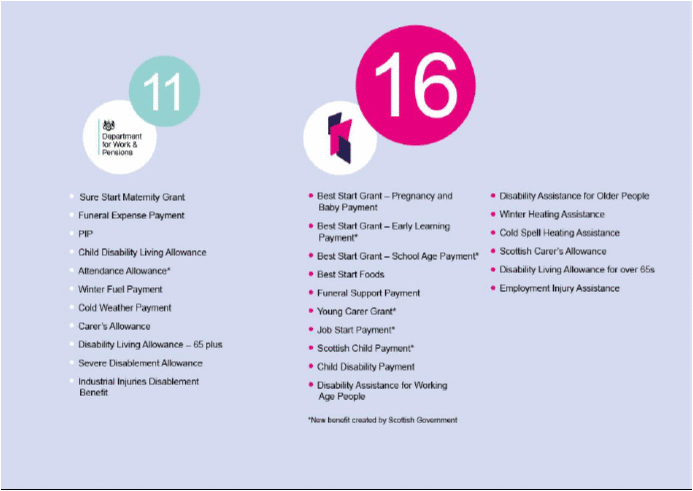
Management Case
A complex Programme needs strong management and governance structures to enable properly impacted decision making, providing assurance around spending and value for money; these are set out in the Management Case of the PBC.
The Social Security Programme uses an Agile approach meaning we are delivering from the start rather than taking a period to specify all our products upfront, which tends to be inflexible. Outline plans are in place and the Agile approach allows us continuously to improve and flex these in response to ongoing learning, particularly following others' experiences of large scale IT projects, and the experiences of our clients. The Agile approach is now an established model for delivery of large scale digital projects across the UK public sector. Audit Scotland recognised that Agile supports the priority of safe and secure delivery by testing and adjusting to deliver across benefits.
Agile means our understanding of the full extent of what will be delivered and the resources necessary evolves. It means we will refine continuously through the life of the Programme to ensure we are responsive to need. The PBC represents our understanding of the Programme at a point in time, and it is used as a reference point for Programme decisions. Programme costs are included in the "Social Security, Advice, Policy and Programme" line of the Scottish Budget.[8]
Commercial Case
The Commercial Case sets out the commercial and procurement arrangements for the Programme. These demonstrate how the Programme will secure value for money and manage commercial risk through the phases of the Programme.
Financial Case
The Social Security Programme is developing and implementing systems to deliver over £4 billion1 of demand-led benefits each year, from 2024-25, safely and securely. The assets being created are an investment in the public services which will enable the delivery of social security benefits for decades to come, therefore the PBC sets the upfront investment in the context of a thirty-year lifetime to 2050.
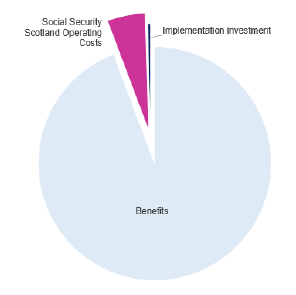
The Scottish Government is making a significant investment to implement the systems required to do this for the future. Current plans indicate spending on implementation will total £651 million from 2018-19 to 2024-25. This one off investment in implementation will benefit the people of Scotland and will be used by future governments for decades. It represents less than 0.5% of the estimated £150 billion[9] in benefits expenditure over the next thirty years. The chart to the right illustrates the relative scale of spending.
The following table sets out what this investment will 'buy', showing the breadth, depth and variety of costs associated with delivering this new public service at this scale. One of the key areas of the investment that the Scottish Government is making in social security is in developing the enabling capabilities which Social Security Scotland needs to deliver safely and securely, including, for example, the infrastructure to support local delivery, the service design for assessments, accessibility and inclusive design, and the telephony service which enables clients to contact Social Security Scotland.
Total Implementation Investment
| Actual | Forecast | |||||||||
|---|---|---|---|---|---|---|---|---|---|---|
| £m | To 2018-19 | 2019-20 | 2020-21 | 2021-22 | 2022-23 | 2023-24 | 2024-25 | 2025-26 | Total | |
| Implementation Investment | ||||||||||
| Live running and Low income benefits | Staff and systems development for Low Income Benefits; support for live running | 16 | 10 | 2 | 3 | 3 | 3 | 1 | - | 38 |
| Disability, Carers and other benefits | Staff costs to support systems and process development for Disability, Carers and other benefits | 3 | 3 | 3 | 3 | 2 | 2 | 1 | - | 17 |
| Case management system development | - | 3 | 10 | 12 | 6 | - | - | - | 30 | |
| Digital Portal system development | - | 3 | 3 | 3 | 1 | - | - | - | 9 | |
| Process and technology development | 3 | 1 | 0 | 0 | 0 | - | - | - | 4 | |
| Assessments | - | - | 7 | 3 | - | - | - | - | 10 | |
| Chief Digital Office | 17 | 24 | 32 | 34 | 33 | 33 | 17 | - | 190 | |
| Scottish Child Payment Implementation | - | 6 | 6 | 7 | 8 | 3 | 2 | - | 31 | |
| Testing & Delivery Integration & other benefits | Staff costs for testing & QA | 0 | 7 | 10 | 10 | 9 | 8 | 4 | - | 49 |
| Staff costs for delivery integration and case management system; Case transfers and Heating Assistance | - | - | 3 | 4 | 3 | 3 | 1 | - | 14 | |
| Case Transfers | - | - | 5 | 0 | 3 | 0 | 0 | - | 8 | |
| Child Winter Heating Assistance | - | - | 1 | 1 | - | - | - | - | 2 | |
| Winter Heating Assistance | - | - | 2 | 2 | 1 | 1 | 1 | - | 6 | |
| Cold Spell Heating Assistance | - | - | 0 | 0 | 1 | 1 | 0 | - | 3 | |
| Other (supporting programme functions) | 1 | - | 0 | 1 | 0 | 0 | 0 | - | 2 | |
| Resourcing, Accommodation & Digital Transformation | Staff costs for Business Analysts | - | 4 | 5 | 6 | 6 | 6 | 3 | - | 31 |
| Staff costs for user researchers and user-centred design | - | 6 | 6 | 6 | 5 | 5 | 3 | - | 31 | |
| Other staff costs including resourcing and accommodation | 4 | - | 2 | 2 | 2 | 2 | 1 | - | 14 | |
| Other resourcing, accommodation & digital transformation costs | 2 | 2 | 1 | 1 | 1 | 1 | 0 | - | 8 | |
| Enabling capabilities | 7 | 12 | 20 | 33 | 29 | 27 | 13 | - | 141 | |
| Social Security Scotland Estates Implementation | 3 | 1 | 7 | - | - | - | - | - | 11 | |
| Total | 55 | 82 | 125 | 131 | 114 | 96 | 48 | - | 651 | |
Figures are shown to the nearest million pounds. Where a "0" is shown, this indicates the figures is less than half a million pounds.
Modelling our operating costs
As Social Security Scotland reaches steady state in 2024-25, its administration costs as a percentage of benefits administered are projected to fall below the comparative figure for DWP. Estimates based on Scottish Government analysis of DWP Annual Report and Accounts indicate that DWP's costs to administer non-pensioner benefits is around 6.3% of the amount paid out; in steady state we estimate the ratio for Social Security Scotland to be around 5%. At this stage, we can predict a highly efficient operation demonstrating strong value for money. This comparison is shown in the chart below[10]. The 2019-20 high point in the early years reflects where Social Security Scotland will recruit and train new staff in advance of the benefit payments being delivered.
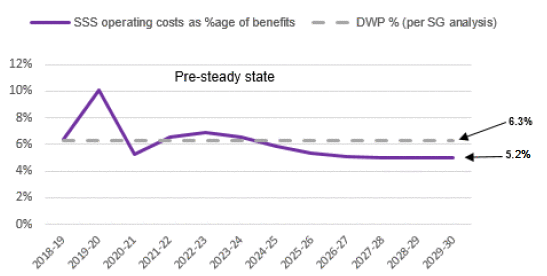
The chart below summarises spending on the Programme, Social Security Scotland, and agency agreements with DWP as Social Security Scotland reaches steady state in 2024-25. Costs of agency agreements reduce over time as Social Security Scotland assumes direct running.
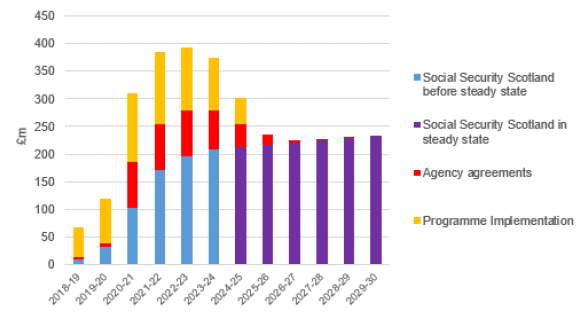
Current position and previous partial estimates
The implementation costs set out in the PBC have been established on a different basis in comparison to those set out in the Financial Memorandum which accompanied the Social Security (Scotland) Act 2018. There are a number of significant areas of difference.
The scope of the Programme has increased. Even between the initial Financial Memorandum produced for the Social Security (Scotland) Bill (June 2017) and the Supplementary Financial Memorandum (following Stage 2 in March 2018) a number of amendments were made to the Bill which added to the delivery requirements.[11] Since the Act became law, a particularly significant change in scope is the addition of the Scottish Child Payment. By itself, this large new benefit increases the number of potential cases that Social Security Scotland will manage by around half a million per year. As well as increasing direct costs, this important benefit means the Programme will of course take longer than previously envisaged.
In addition, while it was clear the Scottish Government must meet DWP's costs of devolution, these costs were unknowable in 2017 when the Financial Memorandum was drafted. Costs set out in the PBC emerged as DWP developed an understanding of the impact of devolution on their systems. The iterative nature of design conversations in an Agile environment means we may see these costs change again. Similarly, we were not able to estimate how much it would cost DWP to deliver on our behalf under agency agreements until detailed discussions had taken place.
Neither were we in a position in 2017 to understand the costs of undertaking the transfer of existing cases from DWP to Social Security Scotland in a safe and secure way. Significant discussion has taken place on how to manage this complex process between both governments, and will continue to iterate until all cases have been transferred.
Under the Fiscal Framework, the UK Government contributed £200 million in respect of one-off implementation costs and added £66 million to the Scottish block grant baseline in respect of administration costs associated with the Scotland Act 2016. These amounts are meant to reflect 'a share of the associated implementation and running costs in the policy area being devolved, sufficient to support the functions being transferred, at the point of transfer' (Smith Commission). It was known at the time of these negotiations that the likely overall costs of delivering social security in Scotland would be higher than these transfers.
The Scottish Government remains committed to funding social security to ensure the system can deliver the service set out in the PBC and future funding will be formally allocated through budget processes.
Conclusion
The Programme Business Case is a powerful record of the largest exercise in devolution since the Scottish Parliament was reconvened. It provides an evidence-based rationale for decisions that have been taken and an assessment of what structures and spending will be needed to make our aims a reality. Its publication is an important milestone for the Programme, indicating a level of maturity in terms of the aims, scope and critical success factors. Ultimately, its value will be felt by the people of Scotland for decades to come, ensuring that in delivering social security in Scotland we have created a new public service that has dignity, fairness and respect at its heart, and that it meets the needs of the people of Scotland. As a Social Security Scotland client put it, "I am blown away by the fact this was the most straightforward benefits application I have ever done. If this is the future of devolved benefits in Scotland then I feel a great sense of hope."[12]
Contact
There is a problem
Thanks for your feedback